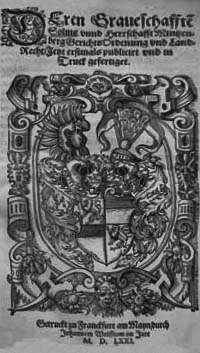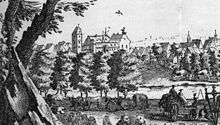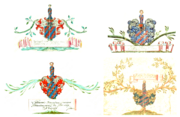Groschlag (noble family)


The Groschlag zu Dieburg were originally an ancient noble family from southern Hesse from the Odenwald and the Rhine . At times there were several side lines, but they all died out after a few generations.
Surname
The name "Groschlag" (also Graslack (e) , Grasloc or Gravesloc , Graslach , Graslacke Gra (i) szloch , Gras (z) lag (k) , Groszlock , Graislock , Grasch (s / ß) lag , Graeslach , Groschlach and Gro (e) schlagk ) corresponds to that of the Groschlag desert between Frankfurt am Main and Hanau . However, there is no documentary evidence that the gender name is derived from it. The ancestral seat of the lords and barons that gave their name was the town of the same name, Dieburg , where they had achieved prestige and dignity as the Burgmanns of Dieburg Castle since the 12th century .
history
middle Ages
According to the critical scrutiny of Johann Gottfried Biedermann's records (cf. literature), one Friedrich Groschlag 942, one Wolfgang Groschlag 996, and another knight of this name 1080 were recorded at knight tournaments . The lord Anselm Groloch from 1254 listed therein is otherwise not documented, but between 1236 one (or more) Rudolfus Grasloc (Grawesloc) as the Munzenberg Vogt and as a witness in the marriage engagement of Adelheid von Tübingen and Kuno II von Munzenberg .
Since 1254 they are as Burgmannen with the villages of Münster , Werlach (now deserted ) Messel (still 1443 Münzenberg- Eppsteinisches fief of Groschlag) and Eppertshausen invested . Rudolf Groschlag is enfeoffed by Ulrich von Munzenberg with the Kistelberger mill near Dieburg. Rudolf had a brother and three sons. The same enfeoffment took place in 1269 - but this time from the diocese of Mainz (the or one of the Rudolf (s) is now vice cathedral to St. Peter and Alexander in Aschaffenburg ). In 1276 a Rudolf von Groschlag sold his goods in Großrohrheim ( Gernsheim ) to the Otterberg monastery .
The family owned extensive fiefs in and around Dieburg with castle and man fiefs , various goods and shares in the high court of the diocese of Mainz . With the end of the 13th century they came to a small territory, the north-east of Dieburg as far as the office Babenhausen handed and the places Saibach , Sickenhofen and Hergershausen included and the rule of Hanau to feud went. From the Fulda monastery they had a third of the place Raibach as a fief and received goods in Umstadt , Ostheim , Seligenstadt and in the free court Alzenau . As early as 1276, the Groschlags were enfeoffed with fiefs in the village of Klein -zimmer. Goods in Groß -zimmer , Urberach and Ober-Ramstadt followed.
In 1304 a Grasloc from Cronenberg is documented, who sold his estate in Altendieburg to Theodoric called Zenechin , knight of Bommersheim . These Grasloc from Cronenberg are a branch line of those from Kronberg , which came from Groschlag with the name of the woman, were also entitled to inheritance there, but died out after a short time.
1343–1374 the Groschlag appointed provost in the Höchst monastery . The first half of the 15th century was marked by extensive extensions of ownership by Heinrich the Elder, Henne and Heinrich the Younger von Groschlag and their sons (Phillipp, Heinrich and Hans). The small domains north of Dieburg (Messel, Eppertshausen and Münster) and west of Babenhausen (Hergershausen and Sickenhofen) were expanded. In the course of the change of rulership in the Umstadt condominium , their fiefdoms in the area of the Fulda Monastery were transferred to the Electoral Palatinate .
Until his death in 1419, a Heinrich von Groschlag Burgmann was in Starkenburg Castle and in possession of a castle loan from Archbishop Konrad III of Mainz .
In the 15th century they were Burgmannen at Breuberg Castle and, next to the Echter von Mespelbrunn , had the largest share of the castle fiefdom.

Early modern age

Since 1496 ( Weistum ) they owned the lower court district Westerngrund of the imperial knighthood territory Krombach district court . After the Lords of Rieneck died out in 1559 and the succession to the diocese of Mainz, they bought the entire jurisdiction of the Krombach office , which they owned until 1666. Inglorious are the witch trials conducted by the district court lords Groschlag, in which over 50 people were killed between 1627 and 1629.
In 1576 they are documented as one of the landlords of Rembrücken . In 1685, Johann Philipp Ernst von Groschlag , Electoral Mainz privy councilor and bailiff in Gernsheim, achieved that Emperor Leopold elevated him to the rank of baron.
In the domain of the family, the Solms land law became common law. The background to this was that the surrounding territories also adopted this "modern" law from 1571, which was recorded systematically and in writing and which also came from the immediate vicinity. The Common Law was now considered only when the Solmser land law contained no provisions for a fact. The Solms land law also remained in force in the Grand Duchy of Hesse , which was only replaced on January 1, 1900 by the civil code that was uniformly applicable throughout the German Empire .
From 1687 he built the Groschlag'sche Schloss Stockau , to which a castle garden was added by Friedrich Carl Willibald Freiherr von Groschlag zu Dieburg in the 18th century, which Johann Wolfgang von Goethe also visited. The family belonged with the Ulner von Dieburg to the most important noble family in western Bachgau and were assigned to the knighthood of Odenwald in the Franconian knightly circle of the imperial knighthood.
In 1723 Philip Carl Anton married Freiherr von Groschlag zu Diepurg, Herr zu Messel, Sickenhofen, Hergershausen and Eppertshausen, the Imperial and Royal Privy Council and Chamber Court President of Wetzlar , Knight of the Royal Polish White Eagle Order (* 1692 in Dieburg , † 1757 in Wetzlar, 1743–1757 Catholic Reich Chamber Court President) Maria Philippina Franzisca Freiin von Bicken (only female descendant of this Wetzlar noble house).
The Groschlag were at times Burgmanns of Friedberg Castle and probably owned the Wasserburg Klein -zimmer by 1626 at the latest .
The line died out in 1799 with the death of Friedrich Carl Willibald Freiherr von Groschlag zu Dieburg in the male line. The fiefs fell to the Landgraviate of Hessen-Darmstadt . Only Eppertshausen and the Klein-Zimmerer property remained with the female descendants and only finally came to the Grand Duchy of Hesse in 1826 . The last female descendant of the Groschlag noble family was Countess Anna Maria von Lerchenfeld -Köfering (1775-1854), who was married to Maximilian Emanuel Graf von and zu Lerchenfeld (1772-1809), Bavarian envoy to the Reichstag , in Dresden and Kassel . She handed over the castle with the associated fields to the community of Klein -zimmer , it was acquired in 1864 by Bishop Emmanuel Wilhelm von Ketteler for the so-called “St. Joseph's Knabenanstalt” and today's St. Joseph's House. In 1854 this last granddaughter died in Köfering near Regensburg .
Documents, archives
The Groschlag archive from Seligenstadt came to the Hessian State Archive in Darmstadt in 1880 and 1912 . In 1954 and 1962 further Groschlag collections from other departments were combined there.
coat of arms
In blue, three inclined bars (inclined left bar) made of red and silver in two rows, a golden crown diagonally between the first and second bar. The crest is a growing man's trunk in a blue robe, as evidenced by the shield. The helmet covers were red and silver in the Siebmacher , blue and silver in the Aschaffenburg coat of arms , blue and gold in Zobel , the latter two sources also depicted without the crown and the chess bars are shown diagonally to the right.
Eppertshausen municipal coat of arms, in which the Groschlag coat of arms, the former owner of the village , was entered with a blue shield and inclined beam (clovers and storks are assigned to the von Wasen ).
Coat of arms of the municipality of Messel , in the upper half of which reference is made to the former Lord von Groschlag with the shield color, which is also blue-like and triple inclined right-hand bar.
Various coats of arms of the Groschlags from ancestral samples in the 18th century. Above left the coat of arms of Friedrich Carl Willibald Freiherr von Groschlag zu Dieburg
Others
A painting by the baroque painter Georg Melchior Kraus (1737-1806), which is kept in the Germanisches Nationalmuseum in Nuremberg with the title Trigonometric Disput (The Trigonometric Dispute) , represents the Groschlag couple Friedrich Carl Willibald Freiherr von Groschlag zu Dieburg (1729-1799) and his wife Freiin Sophie Helene, née Countess von Stadion (1753–1828), was probably created around 1774.
Well-known namesake
- Balthasar von Groschlag zu Dieburg (before 1479–1535), Canon of Mainz
- Friedrich Carl Willibald von Groschlag zu Dieburg (1729–1799), diplomat
literature
- Gerhard Fridrich Albrecht: Genealogical manual. Frankfurt a. M. 1776, p. 71 ff. ( Books.google.de ).
- Archive for Middle Rhine Church History. Volume 41, Society for Middle Rhine Church History. 1989, p. 214 ff.
- Big blow. In: Johann Gottfried Biedermann : Gender = Register of the Reichs Frey immediate knight creates land to Francken praiseworthy place Ottenwald… Kulmbach / Untersteinach, February 16, 1751, pp. 342–348 ( books.google.de ).
- Heinrich Bingemer: The Frankfurt coat of arms booklet. 2nd Edition. Kramer, Frankfurt 1987, ISBN 3-7829-0348-X , p. 21 plate 14.
- Karl Diel: A park model from the time of Goethe. The pleasure garden of the barons of Groschlag zu Dieburg. Darmstadt 1941, LC Wittich Verlag.
- Karin-Jutta Krüger: Karl Friedrich Willibald von Groschlag (1729–1799): A contribution to the Electoral Mainz policy and to the enlightenment in the Rhine-Main area. Munich, 1970.
- Peter Murmann: Balthasar Groschlag von Dieburg: a Mainz canon of the Luther era. Volume 11 of Dieburger Kleine Schriften, Verlag AVA, 1995.
- Peter Murmann: Groschlag and Hanau: a source of the 18th century on the Hanau fiefs of the Groschlag v. The castle. Archaeolog. u. Folklore Working group, 1992.
- Johann Wilhelm Christian Steiner : Antiquities and history of the Bachgau in the old Maingau. 3 volumes, Darmstadt 1829; here Volume 3: History of the city of Dieburg and topography of the former centers and offices Umstadt, Babenhausen and Dieburg. ( books.google.de ).
- Hellmuth Gensicke: DOCUMENTS OF THE GROSCHLAG FAMILY v. THE CASTLE; Regesten (156 pieces) (= Repertories of the Hessisches Staatsarchiv Darmstadt ) inventory B 17 (PDF; 160 kB). In: Archive Information System Hessen (Arcinsys Hessen), as of August 2006, accessed on September 16, 2016.
Web links
- Stockau Castle and Gardens . In: Landesgeschichtliches Informationssystem Hessen (LAGIS).
- The Eppertshausen Atonement Cross as an example of financing the construction of a chapel
- The coat of arms of the Groschlag in the Aschaffenburg coat of arms book
- Dieburg Castle on burgenwelt.de
- Portrait of the last ancestor: Friedrich Carl Willibald Freiherr von Groschlag (1729–1799)
Individual evidence
- ↑ Sometimes the name is spelled differently several times in the same document. The form of the name changed from Grasloc in the 13th century , to Graszlagk in the 15th century , to be changed at the beginning of the 16th century in Groslag or Graheslag and from the middle of the 16th century in Groschlach until the end of the 16th century in slightly different spellings the uppercase (partly written in the form sz and gk ) interspersed.
- ↑ Journal for the History of the Upper Rhine Volume 6, Grossherzogliches General-Landesarchiv zu Karlsruhe, Karlsruhe 1855, p. 305.
- ↑ See: Stammliste des Kronbergs
- ↑ One of the three villages around the castle Dieburg, which was rebuilt in the 12th century in the Wildbann Dreieich , now part of the city of Dieburg
- ↑ ACTIVE LEHEN, feudal and noble letters of Hesse-Darmstadt and other predecessors of the Grand Dukes of Hesse. (= Repertories Hessisches Staatsarchiv Darmstadt ) Holdings A 5, p. 142 (PDF; 669 kB). In: Archive Information System Hessen (Arcinsys Hessen), as of August 2007, accessed on September 16, 2016.
- ↑ Würzburg Diocesan History Sheets (PDF; 2.2 MB) 64th volume, special edition, Würzburg 2002, Dieter Michael Feineis: Die Bickenbacher und die Herrschaft Hohenberg , p. 24.
- ↑ The castle got its name from the Stockau desert , which developed through Stocken (1379), Stockenau (1429), Stockaw (1593), Stockhaw (1545) to designate Stockau Castle and at that time near Dieburg (now part of the city) lay.
- ↑ Monument conservation questionnaire as part of the village renewal Hofstädten , community Schöllkrippen, district Aschaffenburg, administrative district Unterfranken (PDF; 3.5 MB), p. 9-10 and community alliance Kahlgrund-Spessart - community Krombach ( Memento des Originals from March 9, 2016 in Internet Archive ) Info: The archive link was inserted automatically and has not yet been checked. Please check the original and archive link according to the instructions and then remove this notice.
- ↑ Arthur B. Schmidt: The historical foundations of civil law in the Grand Duchy of Hesse . Curt von Münchow, Giessen 1893, p. 106, as well as the enclosed map.
- ^ Sigrid Jahns: Das Reichskammergericht and its judges , Part 1, Böhlau Verlag, Cologne Weimar Vienna 2011, ISBN 978-3-412-06403-7 . P. 678
- ↑ Heraldry website Bernhard Peter the Groschlag'sche coat of arms on the baroque St. Georgsbrunnen of Friedberg Castle
- ↑ City of Eppertshausen - coat of arms history ( page no longer available , search in web archives ) Info: The link was automatically marked as defective. Please check the link according to the instructions and then remove this notice. (PDF; 92 kB).
- ↑ Anzeiger des Germanisches Nationalmuseum 2007 (PDF; 566 kB) Brief contents p. 10.
- ↑ Main-Echo online service : Painting proves family quarrel in the Groschlag home - Heimatverein: Hans Dörr presents an unknown image. dated October 12, 2011.






